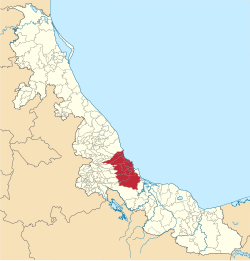Sotavento Region Región del Sotavento | |
|---|---|
Region | |
 Sotavento Region in the State of Veracruz | |
| Country | |
| State | Veracruz |
| Largest city | Veracruz |
| Municipalities | |
| Area | |
• Total | 3,960.69 km2 (1,529.23 sq mi) |
| • Rank | 8th |
| Lowest elevation | 0 m (0 ft) |
| Population | |
• Total | 1,085,751 |
| • Rank | 4th |
| • Density | 274.132/km2 (709.998/sq mi) |
| Time zone | UTC−6 (CST) |
| • Summer (DST) | UTC−5 (CDT) |
| Largest municipality by area |
|
Sotavento Region is one of the regions of Veracruz, Mexico. [3] [4]